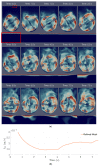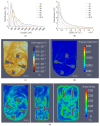Characterization of the Aeration and Hydrodynamics in Vertical-Wheel™ Bioreactors
- PMID: 36004911
- PMCID: PMC9405225
- DOI: 10.3390/bioengineering9080386
Characterization of the Aeration and Hydrodynamics in Vertical-Wheel™ Bioreactors
Abstract
In this work, the oxygen transport and hydrodynamic flow of the PBS Vertical-Wheel MINI™ 0.1 bioreactor were characterized using experimental data and computational fluid dynamics simulations. Data acquired from spectroscopy-based oxygenation measurements was compared with data obtained from 3D simulations with a rigid-lid approximation and LES-WALE turbulence modeling, using the open-source software OpenFOAM-8. The mass transfer coefficients were determined for a range of stirring speeds between 10 and 100 rpm and for working volumes between 60 and 100 mL. Additionally, boundary condition, mesh refinement, and temperature variation studies were performed. Lastly, cell size, energy dissipation rate, and shear stress fields were calculated to determine optimal hydrodynamic conditions for culture. The experimental results demonstrate that the kL can be predicted using Sh=1.68Re0.551Sc13G1.18, with a mean absolute error of 2.08%. Using the simulations and a correction factor of 0.473, the expression can be correlated to provide equally valid results. To directly obtain them from simulations, a partial slip boundary condition can be tuned, ensuring better near-surface velocity profiles or, alternatively, by deeply refining the mesh. Temperature variation studies support the use of this correlation for temperatures up to 37 °C by using a Schmidt exponent of 1/3. Finally, the flow was characterized as transitional with diverse mixing mechanisms that ensure homogeneity and suspension quality, and the results obtained are in agreement with previous studies that employed RANS models. Overall, this work provides new data regarding oxygen mass transfer and hydrodynamics in the Vertical-Wheel bioreactor, as well as new insights for air-water mass transfer modeling in systems with low interface deformation, and a computational model that can be used for further studies.
Keywords: Kolmogorov; LES; OpenFOAM; Sherwood; WALE; energy dissipation rate; homogeneity; human induced pluripotent stem cell; mass transfer; mesh refinement; optimization; oxygenation; partial slip; rigid-lid; shear stress; stirred suspension bioreactor; vertical-wheel.
Conflict of interest statement
The authors declare no conflict of interest.
Figures
















Similar articles
-
Overcoming bioprocess bottlenecks in the large-scale expansion of high-quality hiPSC aggregates in vertical-wheel stirred suspension bioreactors.Stem Cell Res Ther. 2021 Jan 13;12(1):55. doi: 10.1186/s13287-020-02109-4. Stem Cell Res Ther. 2021. PMID: 33436078 Free PMC article.
-
Revealing hydrodynamic effects on flocculation performance and surface properties of sludge by comparing aeration and stirring systems via computational fluid dynamics aided calculation.Water Res. 2020 Apr 1;172:115500. doi: 10.1016/j.watres.2020.115500. Epub 2020 Jan 14. Water Res. 2020. PMID: 31986396
-
Production of oncolytic adenovirus and human mesenchymal stem cells in a single-use, Vertical-Wheel bioreactor system: Impact of bioreactor design on performance of microcarrier-based cell culture processes.Biotechnol Prog. 2015 Nov-Dec;31(6):1600-12. doi: 10.1002/btpr.2158. Epub 2015 Sep 4. Biotechnol Prog. 2015. PMID: 26289142
-
Bioreactor scale-up and oxygen transfer rate in microbial processes: an overview.Biotechnol Adv. 2009 Mar-Apr;27(2):153-76. doi: 10.1016/j.biotechadv.2008.10.006. Epub 2008 Nov 12. Biotechnol Adv. 2009. PMID: 19041387 Review.
-
Hydrodynamics, Fungal Physiology, and Morphology.Adv Biochem Eng Biotechnol. 2015;149:55-90. doi: 10.1007/10_2015_304. Adv Biochem Eng Biotechnol. 2015. PMID: 25652005 Review.
Cited by
-
Scalable manufacture of therapeutic mesenchymal stromal cell products on customizable microcarriers in vertical wheel bioreactors that improve direct visualization, product harvest, and cost.Cytotherapy. 2024 Apr;26(4):372-382. doi: 10.1016/j.jcyt.2024.01.009. Epub 2024 Feb 15. Cytotherapy. 2024. PMID: 38363250 Free PMC article.
-
Analytical Investigation of the Impact of Jet Geometry on Aeration Effectiveness Using Soft Computing Techniques.ACS Omega. 2023 Aug 23;8(35):31811-31825. doi: 10.1021/acsomega.3c03294. eCollection 2023 Sep 5. ACS Omega. 2023. PMID: 37692205 Free PMC article.
-
Robust bioprocess design and evaluation of commercial media for the serial expansion of human induced pluripotent stem cell aggregate cultures in vertical-wheel bioreactors.Stem Cell Res Ther. 2024 Jul 29;15(1):232. doi: 10.1186/s13287-024-03819-9. Stem Cell Res Ther. 2024. PMID: 39075528 Free PMC article.
-
Measurement of Oxygen Transfer Rate and Specific Oxygen Uptake Rate of h-iPSC Aggregates in Vertical Wheel Bioreactors to Predict Maximum Cell Density Before Oxygen Limitation.Bioengineering (Basel). 2025 Mar 22;12(4):332. doi: 10.3390/bioengineering12040332. Bioengineering (Basel). 2025. PMID: 40281691 Free PMC article.
-
Emerging technologies towards extracellular vesicles large-scale production.Bioact Mater. 2025 Jun 13;52:338-365. doi: 10.1016/j.bioactmat.2025.06.005. eCollection 2025 Oct. Bioact Mater. 2025. PMID: 40585384 Free PMC article. Review.
References
-
- Borys B.S., Dang T., So T., Rohani L., Revay T., Walsh T., Thompson M., Argiropoulos B., Rancourt D.E., Jung S., et al. Overcoming bioprocess bottlenecks in the large-scale expansion of high-quality hiPSC aggregates in vertical-wheel stirred suspension bioreactors. Stem Cell Res. Ther. 2021;12:1–19. doi: 10.1186/s13287-020-02109-4. - DOI - PMC - PubMed
-
- Rodrigues C.A., Silva T.P., Nogueira D.E., Fernandes T.G., Hashimura Y., Wesselschmidt R., Diogo M.M., Lee B., Cabral J.M. Scalable culture of human induced pluripotent cells on microcarriers under xeno-free conditions using single-use vertical-wheel™ bioreactors. J. Chem. Technol. Biotechnol. 2018;93:3597–3606. doi: 10.1002/jctb.5738. - DOI
-
- Nogueira D.E., Rodrigues C.A., Carvalho M.S., Miranda C.C., Hashimura Y., Jung S., Lee B., Cabral J. Strategies for the expansion of human induced pluripotent stem cells as aggregates in single-use Vertical-Wheel™ bioreactors. J. Biol. Eng. 2019;13:1–14. doi: 10.1186/s13036-019-0204-1. - DOI - PMC - PubMed
-
- de Sousa Pinto D., Bandeiras C., de Almeida Fuzeta M., Rodrigues C.A., Jung S., Hashimura Y., Tseng R.J., Milligan W., Lee B., Ferreira F.C., et al. Scalable manufacturing of human mesenchymal stromal cells in the vertical-wheel bioreactor system: An experimental and economic approach. Biotechnol. J. 2019;14:1800716. doi: 10.1002/biot.201800716. - DOI - PubMed
Grants and funding
LinkOut - more resources
Full Text Sources

